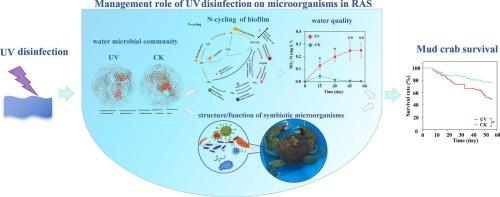紫外线消毒如何增加循环水养殖系统(RAS)中泥蟹的死亡率:来自微生物群落分析的见解
IF 3.9
1区 农林科学
Q1 FISHERIES
引用次数: 0
摘要
在循环水养殖系统(RAS)中,紫外线(UV)消毒被广泛用于改善水质;然而,对其对水生动物生存的潜在不利影响的担忧已经出现。紫外线导致死亡的机制尚不清楚,这使RAS水生物种的有效健康管理变得复杂。我们的研究评估了紫外线消毒对RAS中泥蟹幼蟹存活率的影响,结果显示从76.4%下降到48.6%,具有统计学意义。为了确定影响因素,我们分析了RAS水体中的微生物组成,以及螃蟹肠道和外壳中的微生物组成以及移动床生物膜反应器(mbbr)的生物膜。我们的分析表明,紫外线消毒降低了水中细菌群落的复杂性和稳定性,从而影响了肠道、甲壳和生物膜中的微生物组成。FEAST (fast expected -maximization for microbial source tracking)分析揭示了生物膜和水中细菌群落之间的相互作用,两者对甲壳和肠道细菌群落都有不同程度的贡献。生物膜的宏基因组分析表明,养殖水体中亚硝酸盐含量的升高与微生物动力学的变化有关。肠道和甲壳微生物动力学的功能分析表明,甲壳上的生物膜形成增加,肠道内抗生素生物合成和蛋白质输出功能增强。结构方程模型表明,甲壳细菌群落的变化与幼蟹的存活率有关。此外,紫外线消毒还降低了RAS中ARGs的相对丰度,从而降低了水产养殖废水对环境安全的威胁。因此,建议调整紫外线剂量和消毒时间,避免饲养池前消毒时间过长。本文章由计算机程序翻译,如有差异,请以英文原文为准。

How ultraviolet disinfection increases mortality of mud crabs in recirculating aquaculture systems (RAS): Insights from microbial community analysis
Ultraviolet (UV) disinfection is widely used to enhance water quality in recirculating aquaculture systems (RAS); however, concerns about its potential adverse effects on aquatic animal survival have emerged. The mechanisms underlying UV-induced mortality are poorly understood, complicating the effective health management of aquatic species in RAS. Our study evaluated the impact of UV disinfection on juvenile mud crab survival in RAS, revealing a statistically significant decline from 76.4 % to 48.6 %. To identify contributing factors, we analyzed microbial composition in RAS water, as well as in the gut and carapace of the crabs and the biofilm of moving bed biofilm reactors (MBBRs). Our analysis indicated that UV disinfection compromised the complexity and stability of bacterial communities in the water, which subsequently affected the microbial composition in the gut, carapace, and biofilm. FEAST (fast expectation-maximization for microbial source tracking) analysis revealed an interaction between biofilm and water bacterial communities, with both contributing to the carapace and gut bacterial communities to varying degrees. Metagenomic analysis of the biofilm suggested that changes in microbial dynamics contributed to elevated nitrite levels in the rearing water. Functional analysis of gut and carapace microbial dynamics indicated increased biofilm formation on the carapace, along with strengthened antibiotic biosynthesis and protein export functions in the gut. Structural equation modeling revealed that variation in the carapace bacterial community is correlated with juvenile crab survival. Furthermore, UV disinfection also reduced the relative abundance of ARGs in RAS, thereby reducing the threat to environmental safety posed by aquaculture wastewater. Therefore, it is recommended to adjust the UV dose and disinfection duration, and to avoid prolonged disinfection before the rearing tanks.
求助全文
通过发布文献求助,成功后即可免费获取论文全文。
去求助
来源期刊

Aquaculture
农林科学-海洋与淡水生物学
CiteScore
8.60
自引率
17.80%
发文量
1246
审稿时长
56 days
期刊介绍:
Aquaculture is an international journal for the exploration, improvement and management of all freshwater and marine food resources. It publishes novel and innovative research of world-wide interest on farming of aquatic organisms, which includes finfish, mollusks, crustaceans and aquatic plants for human consumption. Research on ornamentals is not a focus of the Journal. Aquaculture only publishes papers with a clear relevance to improving aquaculture practices or a potential application.
 求助内容:
求助内容: 应助结果提醒方式:
应助结果提醒方式:


